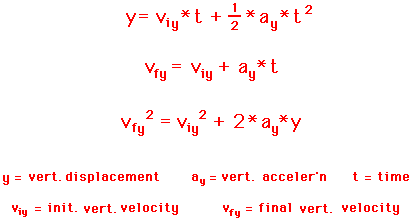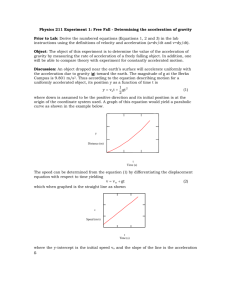



It has been considered that the equations of motion of this case are unsolvable for a general projectile angle, although some solutions have been obtained for a small projectile angle using perturbation techniques. It is well known that the quadratic resistance law is valid in the range of the Reynolds number: 1 × 103 ~ 2 × 105 (for instance, a sphere) for practical situations, such as throwing a ball. We consider the problem of two-dimensional projectile motion in which the resistance acting on an object moving in air is proportional to the square of the velocity of the object (quadratic resistance law). A few studies have reported success in helping students shed their misconceptions, leading to promising recommendations for curriculum development and teaching. Some studies have found that few teachers are aware of their students' misconceptions or know what to do about them.
Freefall position kinematic equation free#
The finding that even college physics students have significant misconceptions about free fall underscores the importance of effective teaching at the middle and high school levels. Although a diversity of misconceptions are found at all age levels, in general children, between the ages of 7 and 9 progress from the idea that things fall because they're not supported to things fall because they're "heavy." Between the ages of 9 and 13, students begin to use the term "gravity," an unseen force, to explain falling, such as "gravity acts just on heavy objects," or "things fall because air is pushing them down." Surprisingly, many high school and college students who can successfully solve numerical problems involving gravity hold qualitative misconceptions similar to those held by much younger students. The body of research is organized by the nature of the findings, beginning with studies of the youngest children, followed by older students, adults, and teachers.

The review begins with a brief historical sketch of how these ideas were developed in human history, followed by a summary of the relevant standards and benchmarks. This first article concerns free fall-how and why objects fall when they are dropped. This article is the first of a two-part review of research on children's and adults understanding of gravity and on how best to teach gravity concepts to students and teachers. So, the verbal-linguistic learning style was better than critical thinking skills. The results showed that there were verbal-linguistic learning style (73.0%), logic-mathematic (67.6%), kinesthetic (60.0%), visual-spatial (60.2%), music (62.0%), and interpersonal (61.1%). Observation is used to find out the types of the students’ learning styles, while tests to measure student’s critical thinking skills. The technique of collecting data uses observation and tests. To analyze the data, the researcher used mix methods (qualitative and quantitative). In this research, the researcher uses descriptive method. This study took sample of students in the first, second and third grade of junior high school. This study aimed to analyze the critical thinking skills of junior high school on natural sciences based on the differences in learning styles. Critical thinking skills can be influenced by several factors, one of them is students’ learning style. Critical thinking skills is one of the skills that must be possessed by students because of the demands in the 2013 curriculum. It required the critical thinking skills of the students in understanding the concept to resolve a problem in society. However, some of the students have misconceptions about the motion system. One of the subject matter in natural science is the motion system that often occurs in daily life. Natural Science is a learning related to everything around us. The results attained have illustrated promising results in which a comparative study between experimental and theoretical methods have presented little to no errors. Hence, the dynamics of the proposed quadrotor are recognised and verified through numerical simulations, leading to presenting the motions of the physical model. By using kinematics approach, one can analyse the expected motion of the UAV after a certain thrust is applied on all motors. Specifically, suitable actuators and propellers have been selected to generate ideal thrusts that will enforce the unmanned aerial vehicle (UAV) to lift. In this paper, the quadrotor dynamics are thoroughly analysed in simulation without using any controllers. However, ensuring that the dynamics are correct and that similar results to a physical model can be obtained has been a question of interest. Over the past decade, control techniques have been widely implemented on quadrotors to achieve the desired positions within the coordinate system.


 0 kommentar(er)
0 kommentar(er)
